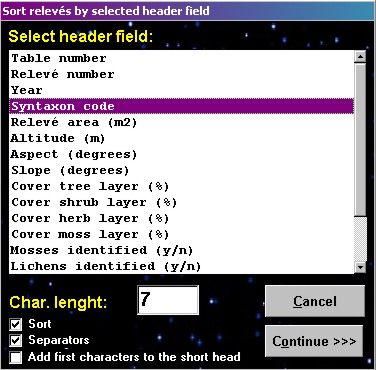Note: Species will be sorted by (1) frequency, (2) order of the relevé with the first occurence and (3) cover value. Note 2: Relevé sorting can be run in a similar way. |
 |
Table sorting
Several types of table sorting are considered to the program. Their next list starts with basic species and relevés sorts, but the program can also sort according to headers, average Ellenberg indicator values, clusters calculated in PC-ORD etc.
Species and relevé sorting
Note: Species will be sorted by (1) frequency, (2) order of the relevé with the first occurence and (3) cover value. Note 2: Relevé sorting can be run in a similar way. |
 |
Other basic types of species sorts
Functions SORT SPECIES ALPHABETICALLY and SORT SPECIES BY LAYERS (menu EDITING AND SORTING) perform alphabetical sorting and sorting by layers (e.g. tree layer, shrub layer, etc.).
Note 2: An information about layer can be displayed from the menu SPECIES and LAYER VIEW. Another way how to highlight different layers by selected colours is stored in the menu SPECIES and MARK LAYERS. Displayed form (bellow) also explain layer numbers used in the table by text identifications.

SORT SPECIES BY MEDIAN COVER - all species will be sorted by their median cover, which is calculated from all species occurences in the current data set.
DEPENDENCE SORTING (menu EDITING AND SORTING) is the function which uses interspecific associations as the main sorting criterion. Interspecific associations between all possible pairs of species are calculated as any selected phidelity index. For every species average values of selected fidelity measure of the three (five or ten) most similar species are indicated, and the dataset is subsequently sorted by these average values.
Basic relevé sorts
The function SORT SHORT HEADERS is useful in many cases where same header or other important relevé data are stored to short headers.
Note: Numbers are sorted in numerical order (1, 2, 3, 11, 12, 13, 21, 22, 23) while text strings are sorted in alphabetical order (1, 11, 12, 13, 2, 21, 22, 23, 3).
The function SORT RELEVÉS BY HEADER DATA allows to change relevés sentence by any header column selected from the list. The user should store several parameters - lenght of character string to be sorted, a check box for making of separators between different header values and a check box for replacement of short headers by selected header data.

Synoptic table sorts
| This type of sort is available if the synoptic table is displayed. Species can be sorted by several different measures. Single sort function is called by the button Sort single column. The method Sort entire dataset is cummulative sorting function - (1) cut level is needed before sorting, (2) all selected species are sorted by the first column, (3) positions of species with the value higher than cut level are fixed and other species are sorted by the second column, (4) positions of species with the value higher than cut level are fixed and other species are sorted by the third column... |  |
Relevé sorts by clusters made by PC-ORD
The program
JUICE allows relevé sorting by clusters of selected
cluster method made by PC-ORD.
|
 |